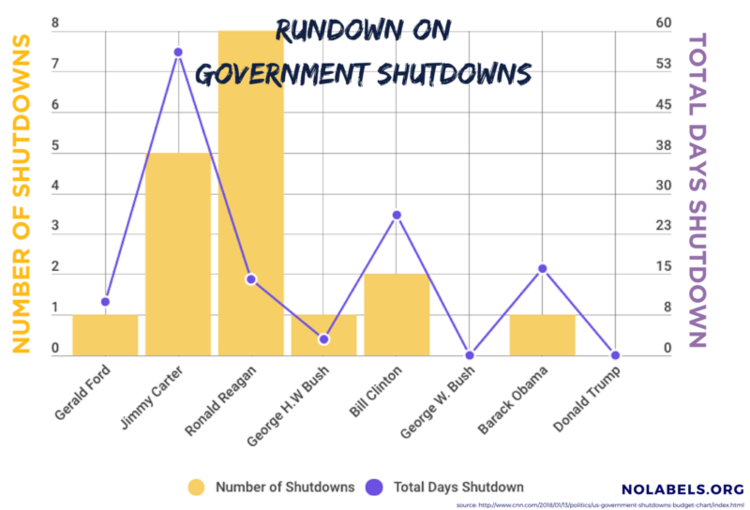What You Need to Know About Government Shutdowns

Congress has until January 19 to pass a spending bill to fund the federal government through the fiscal year that ends September 30, 2018. If lawmakers do not pass a bill with a short- or long-term funding solution by this deadline, the country will face a government shutdown. This means that all nonessential federal employees will be furloughed, closing national parks and monuments and shutting down agencies such as the Centers for Disease Control and the National Institutes of Health.
With the deadline less than a week away, here are five facts you need to know about previous government shutdowns and their economic impacts:
1. Since 1977, there have been 18 funding gaps, or times during a fiscal year when appropriations for specific projects or activities are not passed into law.
Most of these gaps have shut down government services, according to a Congressional Research Service report. While many of these government shutdowns were short (three days or fewer), the 1996 shutdown lasted a record 21 days. The most recent government shutdown, which happened in 2013 during the Obama administration, went on for 16 days.
2. Every president since Gerald Ford, except for Donald Trump and George W. Bush, has experienced at least one government shutdown while in office.
President Ford (R) had one government shutdown; President Carter (D) had five; President Reagan (R) had eight; President H.W. Bush (R) had one; President Clinton (D) had two; and President Obama (D) had one.
3. A government shutdown today would cost $6.5 billion a week, or almost $1 billion a day, according to a 2017 Standard and Poor’s report.
In 2013, Standard and Poor’s estimated that year’s 16-day shutdown cost roughly $24 billion in lost economic output. The Council of Economic Advisors found that the 2013 shutdown caused roughly 120,000 fewer jobs to be created in the private sector. It also resulted in 6.6 million days of lost work and roughly $2 billion in back pay.

4. A continuing resolution (CR) is legislation that allows the government to continue spending at present levels. CRs have often been used to give lawmakers more time to pass permanent funding solutions.
According to a General Accounting Office report, such legislation has been used to avoid government shutdowns an average of five times a year since 1999. The report also highlights that, over the past four decades, Congress has managed only four years without issuing a CR. The last CR was issued by Congress in December 2017, which funded the government for roughly another month.
5. The impact of a government shutdown is not limited to public-sector employees, but is felt across the country.
The 2017 Standard and Poor’s report highlights the profound ripple effect of these government shutdowns:
A disruption in government spending means no government paychecks to spend at the mall, lost business and revenue to private contractors, lost sales at retail shops, particularly those that circle now-closed national parks, and less tax revenue for Uncle Sam.
The result? “Less economic activity and fewer jobs.”
No Labels is an organization of Democrats, Republicans, and independents working to bring American leaders together to solve problems.




